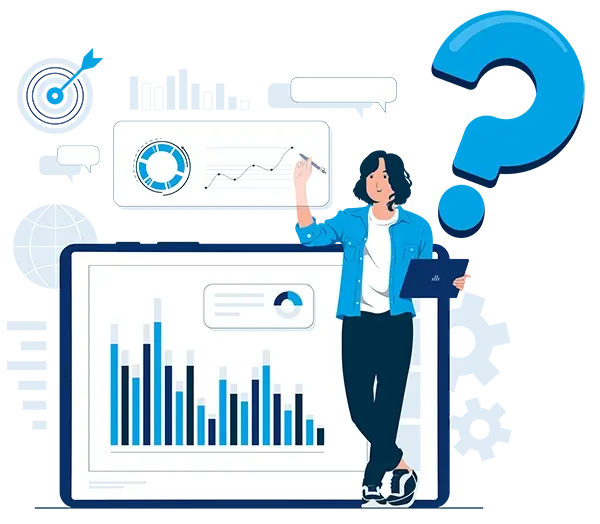Table of contents
Table of contents- Digital Twin: How Can It Facilitate Large-Scale Innovation?
- What is a digital twin?
- How can a digital twin improve your business?
- Predictive analytics and simulation
- Improved operational efficiency
- How can you apply digital twinning in your supply chain?
- Digital twin for the win
- Digital twinning FAQs
Pressure is the ultimate driver of change. As Mark Twain wisely stated: “Necessity is the mother of taking chances.”. And whether you are faced with market volatility or an unmissable opportunity, that’s often when innovation thrives.
Even small, well-intentioned actions can have destructive consequences that supply professionals will be all too familiar with. From switching supplier to shifting service levels or even just expediting orders, the impact of your tactical and operational supply chain decisions can ripple through every department, while misguided strategic initiatives can completely change the course of your business.
Foresight is therefore worth its weight in gold.
This fact was made clear in a recent Gartner Survey, which highlighted that a staggering 60% of businesses are currently piloting, or planning to implement, digital twinning throughout their supply chain.
The reason? Testing, experimenting and challenging your ideas before they’re applied makes sense. By evaluating the potential impact of your initiatives before you take the leap of faith, you can make better decisions which will diminish risk and ensure a far greater chance of new opportunities bearing fruit.
And so the question today is: How can you adopt digital twinning to accelerate innovation and mitigate risk throughout your supply chain?
What is a digital twin?
The idea of a digital twin isn’t new. In fact, the first reference of digital twinning as we understand it today goes back as far as 1991.
David Gelernter first discusses this futuristic concept in his book, ‘Mirror worlds: or the Day Software Puts the Universe in a Shoebox … How It Will Happen and What It Will Mean?
In the book, David explores how “high-tech voodoo dolls” will change the world around us. He presents digital twinning as a revolutionary technology, with the potential to transform computers from handy tools to crystal balls.
To assess the potential of a particular innovation, decision or action, a digital twin allows businesses to monitor, analyse and simulate the likely outcomes, both positive and negative. It will do it in real time, or near real time, allowing you to judge the outcomes without having to manage any risk.
Broadly speaking, in the context of your supply chain, digital twins cover two main areas:
Product Digital Twin:
A product digital twin represents a specific product or item within your portfolio. It captures detailed information about the product’s specifications, characteristics, and lifecycle data.
Process Digital Twin:
A process digital twin focuses on modelling and simulating the various processes and activities within the supply chain. It encompasses the flow of materials and resources across different stages of the supply chain, as well as departments including procurement, production, logistics, and distribution.
The main purpose of a process digital twin is to identify opportunities to optimise process efficiency, identify bottlenecks and simulate what-if scenarios to make data-driven decisions that ultimately enhance the overall supply chain performance.
So now we know what a digital twin is, but how can it improve your operation?
Below we’ll discuss how using your own digital twin can instil value throughout every department of your business. We will explore how you can apply a digital twin right through your supply chain to create better visibility, enhance risk resilience and improve agility.
We’ll also look at the potential barriers you’ll need to overcome and how a digital twin can ultimately improve your decision-making capabilities to create an incubator for innovation.
How can a digital twin improve your business?
Creating a digital twin can help you attain a dynamic view of your supply chain operations. With access to real-time data and a variety of resources used to model the potential outcomes, the value of digital twinning is clear.
The behaviour, performance and characteristics of a real-life, physical counterpart are characterised by an accurate depiction of the process. And as a result, you’ll be able to optimise your operations and formulate far better decisions.
Ultimately, the better the model, the better the real-world decision. This means, the more accurate your data, the more you can explore the variations of outcome.
If you’re a Head of Supply Chain, an Ops Director or Supply Chain Director, here are just a few of the strategic advantages you can unlock by deploying digital twinning throughout your operation:
Real-time monitoring and visibility
A digital twin can give you oversight into the performance of your business. That includes your physical assets, processes, inventory, supply routes and suppliers.
By harnessing digital twinning, you can track and monitor potential outcomes by looking at a number of variables, whether you’re thinking about changes in utilisation, throughput, location, supplier, supply route, weather, cost, or many other different scenarios.
As a result, you can utilise digital twinning to understand whether you’re operating below optimal efficiency or working with anomalies that aren’t blindingly obvious. Equally, you can use this technology to identify where bottlenecks may arise and how this could impact your wider business.
The more you can limit potential disruptions to your supply chain, the better you can plan, and therefore improve, business performance with fewer unknowns.
Predictive analytics and simulation
Whether it’s inventory planning, network design or demand forecasting, you’re far better equipped with more knowledge at your fingertips.
Digital twins allow you to utilise the data you create throughout your business to deploy predictive analytics and advanced simulations. A fully operational digital twin can predict outcomes and evaluate the effect of hypothetical decisions. This in turn ensures your decisions are tested and aren’t just a best guess.
Performance optimisation
How well are your systems and processes performing? Could they be better? Are they truly optimised?
It’s vital to know whether they’re fit for purpose. After all, you know what they say about assumption. Taking the virtual replica and analysing the data will help you make changes, test scenarios, and refine your operations to improve efficiency, cost-effectiveness, and even customer service.
Collaboration and communication
The better your communication, the better your business will operate. Engaging stakeholders in the right areas will improve collaboration at almost every stage. And digital twinning enables this by creating valuable insights that are easily accessible, underpinning coordinated activity and supporting shared decision making.
Improved operational efficiency
Fine-tuning your supply chain is all about pulling levers. However, it’s important to understand how a change in one parameter impacts performance in other areas of your operation.
If you want to streamline your operations, reduce your costs, or improve your efficiency, digital twinning can show you where inefficiencies exist within your business.
Monitor the replica you create in a digital twin, and performance metrics are right there in front of you. Analysing these, alongside potential bottlenecks, and process improvements are far easier to formulate and implement.
Enhanced risk management
As we discussed at the beginning of this article, risk is an unavoidable factor in every decision you make.
Where there’s no choice but to take a risk, the likelihood of achieving a successful outcome is often diminished. Therefore, you must take every possible step to minimise this risk.
Digital twinning can reduce the size of the risk whilst improving the potential outcome. You can simulate a number of scenarios and show the effects on your business of each route you take. The fewer the unknowns, the lesser risk, and the lower your chance of experiencing disruption to your supply chain or wider business in the real world.
How can you apply digital twinning in your supply chain?
We have explored some of the value digital twins can bring to your supply chain and wider business. But in which areas of your supply chain should you apply digital twinning to unlock this potential?
Digital twins can be deployed in many areas of your supply chain. But if we focus on S&OP, there are a number of critical processes where digital twins can really elevate your decision-making capabilities. Let’s explore some of these application in more detail.
What-if analysis and scenario planning
What happens if you change supplier? What if a new international conflict erupts impacting your supply base? What if your market suddenly shifts?
If the world was stable, supply chain planning would be simple. However, there are always unknown unknowns to content with. Thankfully, one of the main advantages of digital twinning is that it allows your business to simulate different scenarios and explore the outcomes.
Having an ace up your sleeve for every eventuality is an incredibly smart move that will help you stay one step ahead of your competitors. Whether you need to explore a potential capacity expansion, new product introductions or changes in market constraint, digital twinning offers unrivalled insight into how every decision you make, from major to mundane, could hit your KPIs.
Demand forecasting
If you could know exactly how many items to stock and what demand would be for the next 12 months, you’d be able to match to the unit your inventory and reduce waste at every step.
By leveraging data captured throughout your business, applying advanced analytics and simulation capabilities, digital twinning empowers businesses to create more accurate forecasts. And from that accuracy comes more aligned inventory levels, improved production planning, and more precise resource allocation.
Inventory optimisation
Inventory optimisation is a balancing act between your desired service levels, your supply chain constraints and optimised costs.
From assessing the potential impact of a service level increase on your investment of working capital, to understanding how a supplier lead time delay could increase your exposure to stockouts, digital twins can help you rationalise inventory decisions to protect availability, optimise your investment of working capital and keep costs under tight control.
By allowing you to test the impact of parameter changes on your operation, you can quickly understand which levers you need to pull to achieve the perfect inventory position.
By allowing you to test the impact of parameter changes on your operation, you can quickly understand which levers you need to pull to achieve the perfect inventory position.
Supply chain network optimisation
In complex, omni-channel environments, the effectiveness of your allocation and replenishment decisions hinge on the business rules you put in place.
But what if you were to make a slight change? What if you decide to adjust the stocking status of an item in a particular location? Or maybe you decide to give certain locations or channels priority?
If these actions are not tested before you roll them out, you can quickly create an imbalanced inventory throughout your network, the result of which is inflated costs, increased waste and a reduction in customer satisfaction.
Ultimately, digital twinning allows businesses to connect the dots by looking at varying factors to model the outcomes of different options. Be it cost, lead time, supplier or service level, you can fine tune your allocation and replenishment process to make your inventory work harder.
Digital twin for the win
We’ve run through the benefits of a full-scale digital transformation in some of our recent articles. And whilst it’s not an easy undertaking, the potential upsides are numerous.
Growth and innovation are two of the most important drivers for success in any modern business. Operating a digital twinning model is a sure-fire mechanism to realising both.
The very best business decisions are based on having the most accurate data at your disposal. By prioritising the accuracy and collection of data sources, you’ll be able to feed this into your digital twin modelling process to increase the benefits of the decisions you make.
That, in turn, will limit risk and improve virtually any decision you take. You’ll leave fewer outcomes to chance and hold a cheat card against any competitor.
You can improve every single process and make your moves into new markets or supply chain developments simple and friction free.
But be wary of the potential roadblocks that are certain to come your way. Creating a digital twin isn’t done easily. You need the input, collaboration and cooperation of every stakeholder in the business.
Manage to get that, however, and you’ll be as equipped as you can possibly be.
Digital twinning FAQs
What is digital twinning in the context of supply chain management?
In the context of supply chain management, digital twinning refers to the creation of a virtual replica or simulation of a physical supply chain system, including its processes, assets and operations.
It involves collecting real-time data from various sources, and using advanced technologies like AI, data analytics and advanced simulation to create a digital representation of the supply chain.
How does digital twinning benefit supply chain management?
By providing a platform for real-time visibility, predictive analytics, scenario planning, process optimisation and improved collaboration, digital twinning benefits supply chain management in several ways.
It enables organisations to monitor and analyse supply chain operations, anticipate disruptions, optimise processes, and make data-driven decisions. With digital twinning, businesses can enhance efficiency, reduce risks, and achieve better coordination across the supply chain network, resulting in improved performance and competitive advantage.
What challenges or limitations are associated with implementing digital twinning in supply chain management?
Implementing digital twinning in supply chain management comes with a few challenges and limitations. Firstly, it requires substantial data integration and infrastructure investments to capture and process data from various sources.
Additionally, ensuring data accuracy and quality is crucial for reliable insights. Organisations may face resistance to change and will require skilled personnel to manage the digital twin effectively.
Finally, the complexity of supply chain networks and the need for cross-organisational collaboration can pose additional implementation challenges. Despite these obstacles, addressing them proactively can unlock the transformative benefits of digital twinning in supply chain management.
How does digital twinning enhance risk management and resilience in the supply chain?
Digital twinning enhances risk management and resilience in the supply chain by providing real-time visibility, predictive analytics and proactive decision-making capabilities. By creating a virtual replica of the physical supply chain, digital twinning enables organisations to monitor and assess potential risks and disruptions in advance. It allows for scenario planning and simulation to evaluate the impact of various risks on the supply chain network.
Through data integration and analytics, digital twinning helps identify vulnerabilities, anticipate potential disruptions, and develop proactive mitigation strategies. By enhancing risk identification, response time and agility, digital twinning strengthens supply chain resilience and enables organisations to navigate uncertainties more effectively.






